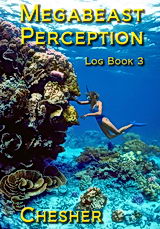Basic Versus Content
Controls and open and closed information systems
Feedback systems are essential to any living system. They create continuity, they invent time. Life seems like a cyclic operation when viewed on a three dimensional plan, only becoming evident as something else when the system is in operation, functioning, in a steady process of becoming.
Feedback systems operate as a digital valve to an analog process. For example, an on-off thermostat control switch clicks on-or-off a continuously variable range of temperatures .
From the viewpoint of the organism/system checking on the condtion of the the governor at different intervals of time, the governor's changes are precisely cyclic. Always coming back to the same message (on/off, right/left) after a series of repeditive events.
From the viewpoint of the flow of information, the governor is invisible. It does not exist when information is flowing (when the switch is on it is just more conductor from the view of the current). It does not exist where there is no information flow. Feedback circuits typically spin on a wheel or oscillate from one state to another to accomplish the alternating feedback activity.
But when viewed from the perspective of the larger environment, the governor is not cyclic and never returns to the same situation again. Think of the behavior of a steam engine on a train as it goes over a mountain. The wheels spin back to the exact same place relative to the locomotive but they are in constantmotion, never twice in the same condition relative to the track, the mountain, the planet, the sun, the galaxy.
Spin is relative; cyclic only when viewed from within the closed organization pattern of the system itself.
Open and Closed Information Systems
Awareness is a closed information system. A being checks predicted conditions at set intervals (usually as fast as it's biochemical network can reset itself).
But awareness is an open, flowing interconnected system in terms of the flow of materials and fuels and events required to create the being and it's awareness.
This is a critical idea because it provides a reflection of the one versus the many misunderstanding. It is also the essence of the larger control systems of the Moirae. It is the key to understanding the torus structure for becoming. But we have to shift metaphors to understand it better.
In an information system, we have a mechanism for communication. A language.
Language is a closed organizational system with strict rules and grammar. But language becomes operational only when it includes content in an open situation with energy (information) flowing through the system.
Language versus Content.
Closed versus open.
We use language to shape thoughts into discrete entities that can be handed around to others and thus act as tributaries to learning for whole populations of people.
Words have meaning in and of themselves - the meaning is the content of the word. Pie - three letters. By themselves, the letters (p,i, e) have no open meaning, they exist only as letters within the closed structure of the information system called the English language.
The concept of a p-i-e as a food is the content that emerges (comes into existence) when the word is scanned by the eyes of a human being who understands the language system and has experienced the contextual event of having seen or eaten a pie and thus knows what the word refers to. The greater the depth of the person's experience with pies (for example a pastry chef, the more content is associated with the word pie.
Language as a Control System
In terms of a computer, Basic is a language - a closed information system that acts as an interface between the user and the flow of electrons within a computer system. Programmers arrange the elements of the language to create local context, thus making the computer respond in specific ways when certain sequences of keys are pressed or the cursor moved to particular places.
The person using the computer adds Content about pies or anything else. The language and local context are a closed information system within the computer. The content is an open information system that flows from the environment to the user through the computer to another user and back to the environment again.
Content guides local context, altering the meaning and thus the response of the being.
The process of learning how to make and bake pies, writing it into a computer file, sending the file to friends on the Internet, and the friends baking the same kinds of pies involves an open flow of information and movement of energy and elements extending from fields of wheat, chickens, cherry trees (if it's a cherry pie), power companies, oil companies, computer companies, oven manufacturers, and so on).
Basic versus Content. The closed organization versus the flow of information through that system.
Nested Languages
Here's where it gets interesting. In nested layers of communications the closed, digital language at each level controls the flow of content that generates the next highest layer of communication web.
Digital signals (the language) have an emergent property. A single signal (such as the letter p ) contains very little content and is clearly digital and closed in nature. A number of digital signals strung together into a series becomes an analog signal relating to the open content. "Have a bite of this delicious cherry pie."
From the standpoint of the cell organelles (the small creatures whose intercommunications create cells) the molecular relationships within the DNA are a digital language. The myriad experiences of the organelles, as they goes through life interacting with the biochemical mechanisms within the cell, are the content they communicate about. The decision about which content to focus on is set by the context and the context is set by whatever it is you are doing.
The language within the strands of DNA determines the range of possible responses but environmental conditions formulate the context in which the organelle reacts and the context moderates the content flowing through the DNA language system. The reactions of the organelle in the context of its environment determine, for example, the "genes" to be expressed or repressed at any given time and the way these genes are expressed. This ability to read and intrepet DNA allows a great range of behavioral expression from what appears to be the same molecular structure in different species.
The molecular arrangement of the DNA is not invented by the organelles. DNA molecular structure is inherited and must be used within the strict rules and regulations of molecular syntax, grammar and spelling. However, the use of the DNA language by the organelles determines if the organelles survive or die and thus the ancestors contribute to the evolution of the language encoded in the threads of DNA.
The Language of Cells
Now consider communications between cells.
The flow of content through the language network of the organelles manifests cells. Cells inhabit a new realm of capabilities and possess a much more complex language that passes information between individual cells (and between cells and multicellular organisms). The language of cells has some elements (molecules) in common with their organelles but these operate in a different media from the one used by the cell organelles.
Cellular language also has new kinds of communications not possible for the smaller organelles. These include tactile information exchanges, electronic pulses, even microwaves. The cellular signals provide interchanges of information between the organism and its environment.
The cells, themselves, did not create this language but inherited it from their ancestors. Again, like the organelles, the cellular ancestors invented the language over a long period of trial and error that operated in parallel with the development of the language of the organelles that formed the original cells.
The language of the cells controls the interactions of the cells with other cells existing in their closed language environment. But what the cells communicate about and with is content, and this is open, flowing through the entire system from sub-atomic particles to the sun.
Cellular Language and Multicellular Organisms
Cellular intercommunications are the "Basic Language" of the multicellular organism. It is a closed information system, but the multicellular organism adds content from its experiences and thus programs in responses that cause the cellular language to make the cells respond in certain ways to particular environmental stimuli. This, in turn, enables the multicellular creature to respond in meaningful ways. Meaningful not to the cells, but to the whole organism and the information system of that organism's society.
Multicellular Organism Language Systems
Now consider communication systems between multicellular organisms.
The flow of content through the communication network of cells creates multicellular organisms and these have a much wider range of communication techniques. They use some of the cellular communication signals (molecular signals like pheneromes, or the scent of flowers, for example) but have other language systems built on visible and audible signals that are entirely different from the cellular language system, even though these exist because of the cellular language system.
Just as the individual cells did not invent their language system or the organelles their language system, the individual multicellular organisms did not invent their language systems, although their ancestors did create it BETWEEN themselves, in a long process of learning and cooperation.
In fact, all of the language systems between individuals at all levels are NEVER invented by the individuals, but always through a system of mutual learning between individuals; it is invented in the communal level of intercommunications between individuals all acting at the same interval of awareness.
Language signals are agreed-upon conventions between individuals. They exist in the flow of information between systems. While the mechanism for using the language - the ears, mouths, fingers, eyes, lungs, nerves - exist as the closed information system of an individual, the intra-individual communication is the open content that flows between individuals.
Language is a closed pattern of information organization. Content is the open flow of information regulated by language. And language is consciousness.
How does this blend in with the concept of the thread of awareness in chaos?
Imagine the molecular flow into the information system of the DNA of the cell organelles. The oxygen, hydrogen, carbon, nitrogen, phosphate flowing into the system. This is the inflow, the focusing from a wide environment into the vortex of the torus. This is the Om, the Being, the Focusing.
Next the elements become organized into "organic" molecules - organelle words of enzymes, proteins and electrostatic charges that are interchanged and interpreted between organelles in their communication network. The organelles order and regulate the production of these words by their collective experience and awareness; the entire process imparts content into the language system. This is the change, Mani, that happens in the center of the vortex.
At this critical inflection point, content and language come together to create something new and different, we flex from an inward to an outward state, from closed to open.
Now the community of organelles begins to respond, to react, to use the language of proteins and enzymes and electrical potential. This response could move in any direction, go any way at all, flower outward into any new direction of the torus. This is Padma, the becoming, the change in change.
The responses have an effect, an interaction, an impact. This is the Hum, the outer perimeter of the torus, it is the "observer" or filter providing feedback on the success or failure of the response. The observer is the assessment of the results of the open flow of information compared to the dictates of the closed language.
And this observer is the emergent being, the cell, integrating it's interior and exterior environmental status.
The critical inflection point, where impact and observation meet, is the focus, the center, of a larger torus - the whole cell. It is also the focus, the origin, of the cellular communication network. So there is a new, larger, torus created by the network of communications of the smaller ones. And so on up through the nested layers of becoming - multicellular organisms, societies, ecosystems.
Decisions and Feedback loops of Content
The outflow from the DNA threads has potential for doing a wide variety of different actions, depending on what the organelles decide, in concert as a living cell, to do.
When the cell makes a decision and responds to environmental stimuli, it "fixes" the future and thus determines the needs for the next round of production of organelle words. It also provides the internal language parameters for the multicellular animal.
When a multicellular animal makes a decision based on the cellular language system, it fixes the future and thus determines the needs for the next round of production of cellular words. It also provides the basis for the language parameters of the society of multicellular animals.
When a society makes a decision based on the language system of its members, it fixes the future and thus determines the needs for the next round of words.
Thus the feedback loops that regulate life are produced by the content - the open flow of information within a specific context according to limits set by the society of individuals. This feedback flows through all of the nested levels of organization modifying the local context and the closed language systems at each successive level.
When the Torus shifts perspective
A torus is only a torus from it's own closed perspective. It is a sine wave from the perspective of its motion through the continuum. We can't envision how the different levels of becoming interact from the viewpoint of the torus, because there is no way to connect them.
Let's examine the torus of a tree with its sunlight and water flows. They seem to be moving in different directions in the "event" structure of the tree. The flow from sunlight comes into the system from the leaves and moves down the branches to the trunk and out through the roots. And the flow of water comes from the ground into the roots and up the branches and out through the leaves. This creates the double branching effect of the tree. But the cycle does not really form a torus because the water and sunlight flowing through the system are never the "same" elements or photons, but always new ones. Just as our breathing is a cycle but the air flowing through the system is always new air, new atoms, entering and leaving.
This divergence from a closed cycle of the language is the essence of content. Content is never twice the same even if the words and cellular signals and molecular responses do their best to maintain constancy. It is the inconstancy of content that balances life on the edge of becoming and destruction, and this is where life survives and grows.



